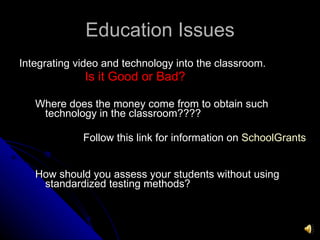Group2 Ppt Ch. 4 & 7
- 1. Evaluating Educational Technology and Integration Strategies Chapter 4 – Hardware Hard to Understand Chapter 7 – Teachers Discovering Computers Getting Students Ready for their Web 2.0 Future “The Tech Treckies” Joy Fierro-Ogden Betsy Huberth Therese Lamica Krista Lissner Dawn Verini
- 2. Introduction Application Software Productivity Tools for Educators Chapter 4 Need to buy or recommend computer equipment? This chapter gives information on many components and provides links to each one. Sites give more details on each component, how it works, and information on purchasing. GREAT for people with limited technology experience. It defines, explains, and provides links to answer questions.
- 3. Teaching Today Teaching today includes integrating technology/devices such as these in the classroom. Graphing calculators Portable storage devices Tablet PCs Questions: Besides USB flash drives, what other portable storage devices might you use is your classroom? How will you use them?
- 4. Handhelds Allowed in Class? Handheld devices, PDAs in the classroom Fuel students’ enthusiasm for reading Improve reading literacy Question: Can PDAs be used to help teach students to be better readers? Lesson plans using handhelds: //kathyschrock.net/power/
- 5. Is Digital Data Disappearing? Up to 75% of today’s data never existed on paper! Rapid changes in technology Digital records inaccessible Can’t access old information. Great ideas from yesterday are gone tomorrow!
- 6. Integration Corner Educators : positive role models Teachers: proficient users of technology Students: opportunities to access Internet and WWW
- 7. Integrating Literacy Software Links to sites offering software Riverdeep.net | Make A Story Graph club Oregon Trail
- 8. Digital Media Corner Cell phones serve as good digital technology Digital cameras, Ipods, CD’s , etc…
- 9. Checkpoint Take the quiz to test yourself on chapter content. http://oc.course.com/sc/tdc5/flash/check point/ch4/index.cfm? action=matching&chapter=4
- 10. Introduction Emerging Technology Chapter 7 Teachers discovering computers. Technology in the classroom its integration, appropriateness, and effectiveness in the classroom. How can we incorporate it into our classrooms? Emerging Technologies Blogs Podcasts Screen casts – Video, multimedia Websites Wiki’s Tapped In
- 11. Integrating Technology in Teaching Today Integrating Software into your classroom Blogging enhances: Cooperative learning Collaboration Motivation
- 12. Education Issues Integrating video and technology into the classroom. Is it Good or Bad? Where does the money come from to obtain such technology in the classroom???? Follow this link for information on SchoolGrants How should you assess your students without using standardized testing methods?
- 13. Evaluating Student Learning with Digital Media Using digital media in your classroom provides many social experiences for your students. Use alternative assessments to evaluate student learning such as: Authentic project-based assessment Portfolio’s Rubrics Self evaluate and peer evaluations. Short answer essays Oral presentations www.teach-nology.com/web_tools/rubrics/
- 14. How do we evaluate the technological tools to use in the classroom? Ways to evaluate Websites & Software Teacher evaluations: Website evaluation rubrics Educational blogs and peer reviews Test the software first before purchasing - ask for demonstration disks or preview copies Student Evaluations Website evaluation rubrics http://school.discoveryeducation.com/schrockguide/evalelem.html
- 15. Curriculum Integration o How do we as teachers incorporate technology into our curriculum? http://oc.course.com/sc/tdc5/index.cfm?action=integrate&chapter=7#Elemen o Use products that allow students to create reports, presentations and video presentations. o Use digital software such as: Inspiration / Kidspiration Adobe Acrobat Adobe Captive Leap Frog Game Maker
- 16. How will you know if a website or software is good or bad quality? Evaluate for the following criteria: Authority Affiliation Purpose and Objectivity Content and Learning Process Audience and Currency Design of the digital media material
- 17. Digital Media in the Classroom What is digital media? CD’s, e-books, Internet, Video games, WWW, Graphic Design Software, etc Integrate “Edutainment” in your lesson plans and classroom entertainment media for learning purposes
- 18. Technology and Teaching Students with Special Needs How will you evaluate the assistive technological needs of your students? Check out the Wisconsin Assistive Technology site: http://www.wati.org/ What types of assistive technologies are available to help: hearing impaired visually impaired physically impaired Assistive Devices Help Challenged Kids Get the Most From Learning http://www.educationworld.com/a_tech/tech/tech086.shtml
- 19. Checkpoint Try your skills – match the questions in the link below…. http://oc.course.com/sc/tdc5/index.cfm?action=matchin
- 20. Timeline A little history of how we got to where we are today…….. Teachers Discovering Computers, Fifth Edition -
- 21. References 1. (June 2009). Education and computer connection. Retrieved July 5, 2009, from Education Index Web site: http://www.nvo.com/ecnewletter 2. (2001). Make a story. Retrieved July 5, 2009, from Riverdeep interactive learning limited Web site: http://www.riverdeep.net/language_arts/edmark_lang_arts/MakeAStory/MakeA 3. Reagan, B. (December 2006). Digital ice age. RetrievedJuly 5, 2009, from Popular mechanics Web site:http://www.popularmechanics.com/ technology/industry/4201645.html 4. Schrock, K. (2003-2006). Power in the palm of your hand. Retrieved July 5, 2009, from Kathy Schrock Web site: http://kathyschrock.net/power/.
- 22. References Reed, Penny. Lalhlm, Elizabeth A.(2004, January). Assessing Students Needs for Assistive Technology, A Resource Manuel for School District Teams, Retrieved July 03, 2009, from Wisconsin Assistive Technology Initiative site: http://www.wati.org/?pageLoad=content/supports/free/index.php Steele-Carlin, Sherril (2006). Assistive Devices Help Challenged Kids Get the Most From Learning. Retrieved July 3, 2009, from Education World Web site: http://www.educationworld.com/a_tech/tech/tech086.shtml Teachnology, Incorporated, Rubric, Rubric Makers. Retrieved July 3, 2009, from Teachnology Web site: http://teach-nology.com/web_tools/rubrics/ Tyburski, Genie (2008, May 12). Evaluating the Quality of Information on the Internet. Retrieved July 3, 2009, from The Virtual Chase Web site: http://www.virtualchase.com/quality/criteria.html
- 23. References con’t. Fernandez, Donna (1999-2008). Retrieved July 6, 2009, from Welcome to School Grants! Web site: http://k12grants.org/ Schrock, Kathy (2008). Kathy Schrock's Guide for Educators. Retrieved July 6, 2009, Web site: http://school.discoveryeducation.com/schrockguide/assess.html Shelly, Cashman, Gunter & Gunter, Retrieved July 6, 2009, from Teachers Discovering Computers Web site: http://oc.course.com/sc/tdc5/index.cfm? action=links&chapter=7






















